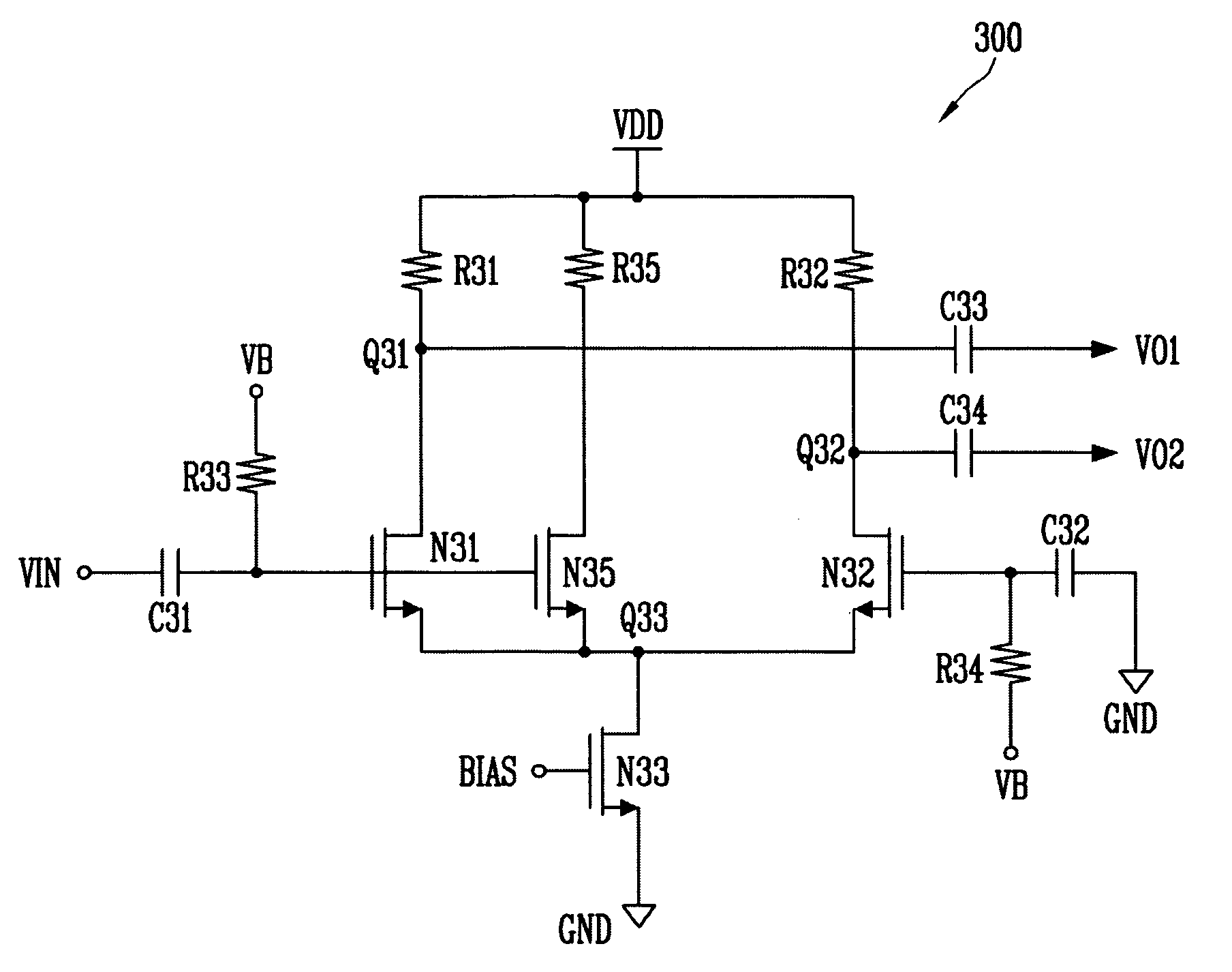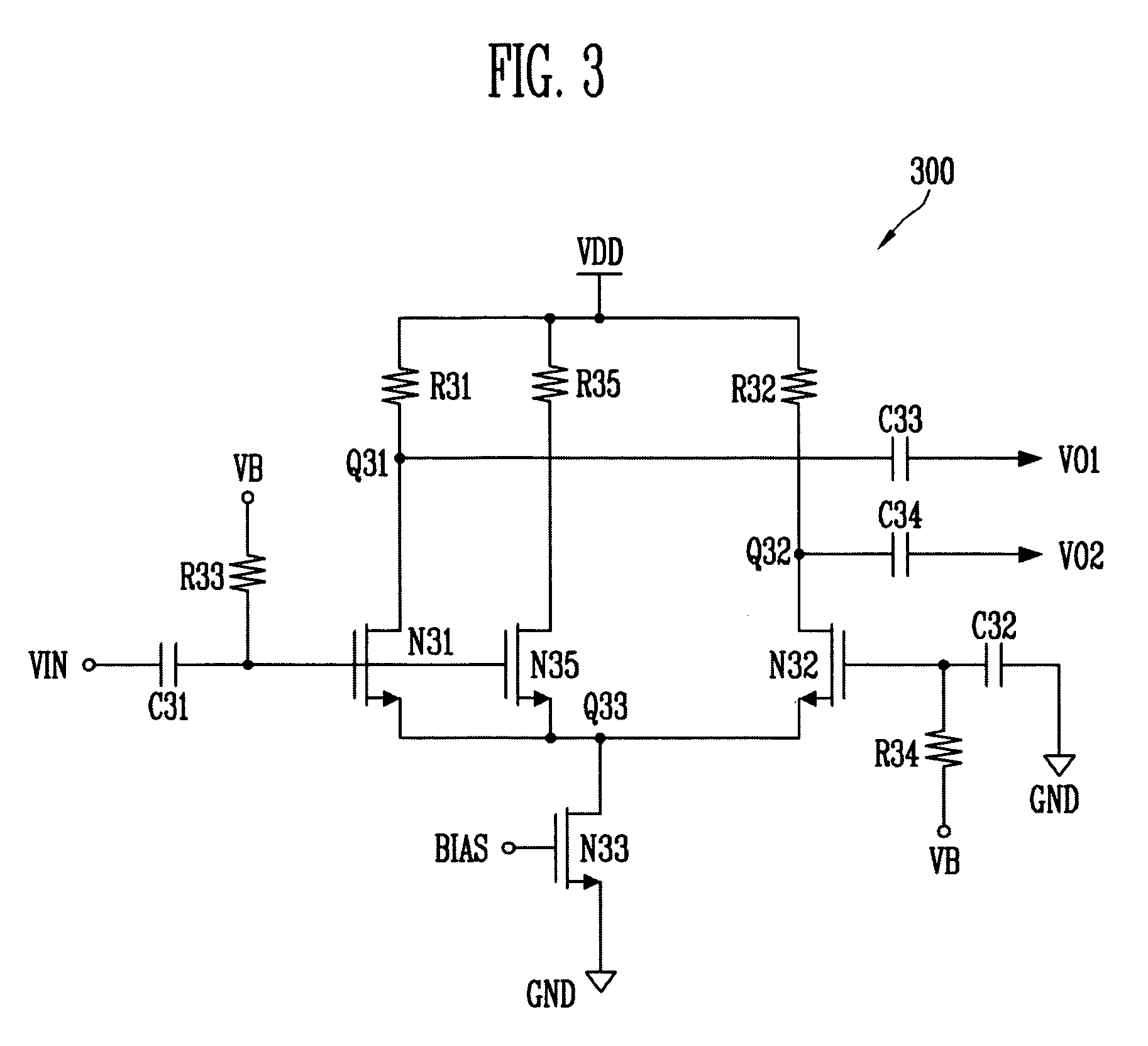Wideband active balun circuit based on differential amplifier
a technology of differential amplifiers and balun circuits, applied in the field of wideband active balun circuits based on differential amplifiers, can solve the problems of difficult application of wideband active techniques, unbalance between two differential output signals, and unbalance between different output signals, so as to achieve the effect of increasing integration density advantages
- Summary
- Abstract
- Description
- Claims
- Application Information
AI Technical Summary
Benefits of technology
Problems solved by technology
Method used
Image
Examples
embodiment 1
[0027]The construction of an active balance-to-unbalance (balun) circuit 300 will now be described with reference to FIG. 3.
[0028]Referring to FIG. 3, a first resistor R31 is connected between a power supply voltage terminal VDD and a first node Q31, and a second resistor R32 is connected between the power supply voltage terminal VDD and a second node Q32. Drain and source terminals of a first NMOS transistor N31 are connected between the first node Q31 and a third node Q33, and drain and source terminals of a second NMOS transistor N32 are connected between the second node Q32 and the third node Q33. A third NMOS transistor N33 having a gate terminal to which a predetermined bias voltage is applied by a bias terminal BIAS is connected between the third node Q33 and a ground terminal GND. A first capacitor C31 is connected between an input terminal VIN and a gate terminal of the first NMOS transistor N31, and a second capacitor C32 is connected between the ground terminal GND and a ...
embodiment 2
[0039]The construction of an active balun circuit 400 will now be described with reference to FIG. 4.
[0040]Referring to FIG. 4, a first resistor RI is connected between a power supply voltage terminal VDD and a first node Q41, and a second resistor R2 is connected between the power supply voltage terminal VDD and a second node Q42. Drain and source terminals of a first NMOS transistor N41 are connected between the first node Q41 and a third node Q43. Drain and source terminals of a second NMOS transistor N42 are connected between the second node Q42 and the third node Q43. A third NMOS transistor N43 having a gate terminal to which a predetermined bias voltage is applied by a bias terminal BIAS is connected between the third node Q43 and a ground terminal GND. A first capacitor C41 is connected between an input terminal VIN and a gate terminal of the first NMOS transistor N41, and a second capacitor C42 is connected between the ground terminal GND and a gate terminal of the second N...
embodiment 3
[0044]The construction of an active balun circuit 500 will now be described with reference to FIG. 5. The active balun circuit 500 can compensate for unbalance between two differential signals and prevent signal leakage and self-mixture caused by interference between input and output nodes.
[0045]Referring to FIG. 5, a first inductor L51 is connected between a power supply voltage terminal VDD and a first node Q51, and a second inductor L52 is connected between the power supply voltage terminal VDD and a second node Q52. A sixth NMOS transistor N56 and a first NMOS transistor N51, which are cascode transistors, are connected in series between the first node Q51 and a third node Q53. A seventh NMOS transistor N57 and a second NMOS transistor N52, which are cascode transistors, are connected in series between the second node Q52 and the third node Q53. A third NMOS transistor N53 having a gate terminal to which a predetermined bias voltage is applied by a bias terminal BIAS is connecte...
PUM
 Login to View More
Login to View More Abstract
Description
Claims
Application Information
 Login to View More
Login to View More - R&D
- Intellectual Property
- Life Sciences
- Materials
- Tech Scout
- Unparalleled Data Quality
- Higher Quality Content
- 60% Fewer Hallucinations
Browse by: Latest US Patents, China's latest patents, Technical Efficacy Thesaurus, Application Domain, Technology Topic, Popular Technical Reports.
© 2025 PatSnap. All rights reserved.Legal|Privacy policy|Modern Slavery Act Transparency Statement|Sitemap|About US| Contact US: help@patsnap.com



